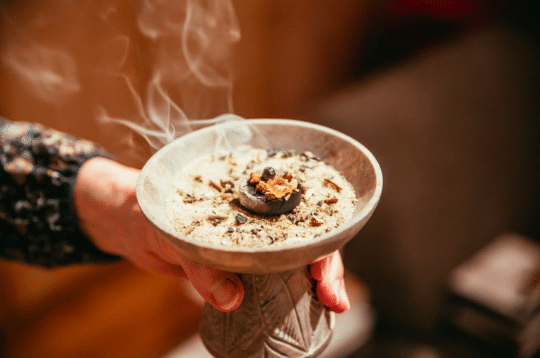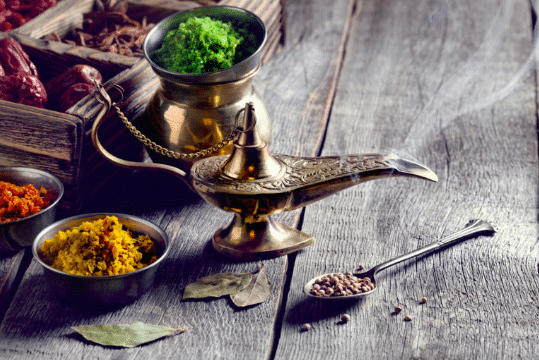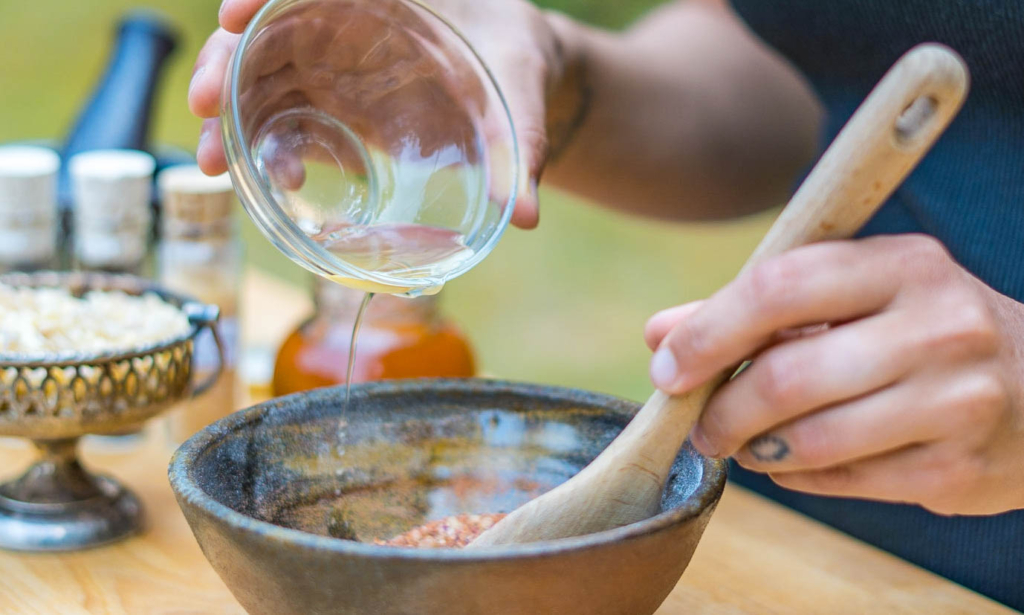
In addition to their pleasant and uplifting aromas, nearly all aromatic plants used in incense also have medicinal qualities. Whether burned for therapeutic, spiritual, or aesthetic purposes, everyone who burns incense inhales its natural aromatic medicine, whether they’re aware of it or not.
The medicine of incense can positively affect the many functions of the mind and memory, the respiratory system and sinuses, heart and circulation, emotional balance, internal organs and digestion, even the skin. Many ancient healers took notice of the effectiveness of plant smoke as a therapy, and incorporated the use of incense into many great systems of natural medicine and healing.
Incense is perhaps the most universal botanical product in the world, with a majority of populations of many Asian and Middle Eastern countries burning it daily. Its multi-faceted nature allows for people from all walks of life to benefit from its countless qualities, whether they use it in prayer, meditation, or ceremony, for pleasure, or as medicine.
On every continent, ancient peoples used the smoke of burning plants to treat patients for countless ailments and illnesses. The original application of plant smoke therapy was to burn aromatic herbs or medicinal tree resins on hot charcoal from a fire, and “bathe” the patient in smoke by fanning it towards them and around their bodies, or allow the patient to take deep inhales of the fragrant fumes for a certain period of time.

The Oldest Form of Aromatic Medicine
Incense is still used today in Indigenous healing ways, often with a focus on a holistic healing of the mind, body, and spirit. Shamans of Ecuador use plants like Palo Santo incense to heal emotional trauma, mental agitation, and many physiological ailments. Native Americans use plants like Cedar, Juniper, and White Sage to heal the spirit, emotional body, and psyche, and to cure countless physiological ailments and illnesses.
North African tribes people still use Frankincense and Myrrh for their anti-microbial and anti-viral properties to fend off viruses and sickness, and to heal psychological problems, respiratory ailments, and many other imbalances.
Outside of the very effective and more simplistic Indigenous use of incense therapy, thousands of years ago certain well-established and renown Eastern systems of medicine, such as the ancient Indian system of Ayurveda, Tibetan medicine, Traditional Chinese medicine, and Coptic medicine, took the application of medicinal incense to a whole new level. This is where the art of more complex formulation and prescription of incense was created.
In Ayurveda and Traditional Chinese medicine, incense is often used as complimentary medicine to other herbal treatments to ensure patients receive a more well-rounded, holistic treatment. This of course depends on the severity of the health issue at hand.
In these holistic treatments, practitioners cater to internal healing through ingested herbs, teas, topical treatments, medicinal foods, or other applications, while also prescribing medicine through the airways (also internal medicine) in the form of incense. This approach adds another layer of depth, treating the root cause and symptoms together from every possible angle.

In many systems of medicine, incense is also effectively used as a standalone treatment. In traditional aromatherapy, TCM, herbalism, and Ayurveda, burning single incense herbs or incense formulas can have very profound results without the need of other applications. Incense formulas, similar to herbal formulas, are a well-thought-out mixture of aromatic plants designed to alleviate symptoms of an illness or imbalance, while also treating the root cause of the illness.
Lead herbs in a formula penetrate to the core of the problem, directly addressing the primary goals of the formula, while other supporting herbs help increase the effects of the lead herbs, and help reduce a patient’s symptoms at the same time.
With incense formulas, supporting herbs can also be used to bring calm or balance to the nervous system, clarity to the mind, or healing on the emotional, spiritual, or psycho-spiritual levels. This can be very beneficial if a patient is not acting like themselves, is stressed out or fearful about being unwell, or needing emotional support.
Learn How to Make Irresistible Incense For
Enjoyment, Healing & Ritual with
✨ The Art of Incense Crafting Ebook ✨
Download Your Free Copy Below

Are you ready to learn how to craft your own natural incense? This free eBook covers the essentials of creating incense that burns beautifully and smells divine, exploring its role as an ancient aromatic medicine and sacred ritual tool. Avoid common pitfalls and unlock step-by-step instructions to make incense cones with ease.
In addition to its medicinal qualities, incense is also the most universal spiritual tool used around the world. Therefore it can bring a much needed spiritual or ritual aspect to any healing taking place for a more well-rounded and holistic healing process. The calming, heart-opening, and spiritual aspects of incense only support and often hasten a patient’s journey to greater health.
“Incense is the very root of medicine, and remains effective to nourish our bodies today. It can outwardly fend off infectious viruses, and inwardly preserve organ functions.”
– Master Li Shiliang
Renowned Master Incense Crafter and Traditional Chinese Medicine Practitioner
In Traditional Chinese medicine, incense is often used as preventative medicine, keeping the organs and bodily systems in good working order. In addition to being used to kill infections and viruses and heal countless physiological and organ imbalances, like those of the kidneys, stomach, and intestines (yes incense can penetrate this deep!), it is also used to keep the mind and memory sharp and the nervous system balanced and nourished.
Ayurvedic physicians traditionally use incense to treat everything from more serious conditions of epilepsy, schizophrenia, and severe depression and anxiety, to the more physical ailments of the lungs and respiratory system like catarrh, bronchitis, coughs, colds, flu, viral infections and both internal and external bacterial and fungal infections. They also use incense for less serious imbalances like strengthening mental cognition, focus, and memory, and balancing and releasing emotions and stress.

The Holistic Nature of Incense
Incense is the traditional roots of modern aromatherapy. Similar to the process of inhaling the aromas of essential oils therapeutically, once the fragrant, medicinal chemical components within an incense are inhaled, they’re taken into the sinuses and lungs. They soon find their way into the bloodstream and brain. From here they go directly to the places within the body they have an affinity towards, to the organs and systems that might need their assistance for healing.
What makes incense different from essential oils however, is that incense is a more whole-istic application of aromatic medicine. Essential oils are most often a fragmented separation of a plant’s full spectrum of medicinal components. The process of distilling essential oils often robs many raw plants of their full healing potential, as the process requires a separation of a part from the whole.
Essential oils certainly have their place, and I use them for many purposes in my own practice of aromatherapy. Incense however, is simply proven to contain all of a botanical material’s constituents, in-tact, which is why it is so effective in therapeutic treatments.

Today, many practitioners of medicine simply aren’t aware that Pine resin in the form of incense can be a potent remedy for treating cough, cold, and flu; or that the smoke of Eucalyptus leaves can relax mucous membranes, open the sinuses and chest, and clear the lungs of phlegm and congestion due to its powerful expectorant properties.
Rarely will any textbook or conventional medical school teacher tell their students that Frankincense is one of the oldest remedies for relieving severe anxiety and stress, calming and rejuvenating the nervous system and bringing clarity and awareness to the mind.
And you might be able to count on your hand the number of health professionals in modern societies who know that the Palo Santo tree is one of the most potent natural sources of the botanical chemical limonene, which oxygenates the brain and leads to positive, heightened mental states; and that Palo Santo incense has been used for millennia for treating patients suffering from depression, sadness, and grief, oftentimes with immediate results.
Knowing and understanding the healing virtues of aromatic incense plants can be a very powerful tool to add to your healing skillset. One small piece of medicinal incense wisdom could make all the difference in the effectiveness of a treatment, whether for yourself, family, or patients.
The problem is, in-depth and quality information about healing with incense can be very difficult to find. That’s why I’m excited to announce that my second long-awaited ebook, “Materia Aromatica, An In-Depth Guide to the Traditional Ritual, Aesthetic, and Medicinal Uses of the Most Common Incense Plants," is finally available to you.

Materia Aromatica is your new professional reference for using popular incense plants for healing and therapeutics. You’ll also learn countless traditional uses for emotional and spiritual support and ritual. Click above to learn more and claim your copy.
If you’re a healer, aromatherapist, herbalist, naturopath, massage therapists, or if you just want to know how to use incense for healing or preventative medicine for yourself or family, this one-of-a-kind ebook can be your gateway to traditional aromatic medicine, and help you take your practice to a new holistic level.
Article by Evan Sylliaasen

Evan Sylliaasen is the founder of the Northwest School of Aromatic Medicine and Higher Mind Incense. For the past decade his incense company has been a leader in sustainability and conscious sourcing of aromatic plants. As the head instructor of his online school, he teaches aromatherapists, incense lovers, herbalists, and spiritually-minded folks the traditional art of incense crafting, incense as medicine, and the art of wild-harvesting aromatic plants responsibly.
Evan lives with his family in the foothills of the Olympic Mountains of Washington state. He channels his creative passions through writing, photography, wood working, craftsman building, and music. When he’s not working, he’s out in the garden, forest and fields, walking along rivers, beaches, or in the mountains breathing deeply.
© 2019-2021 The Northwest School of Aromatic Medicine. All rights reserved.
*The statements above have not been evaluated by the FDA. This article is not intended to diagnose, treat, cure, or prevent any disease.
